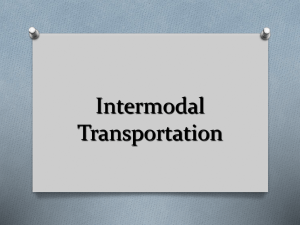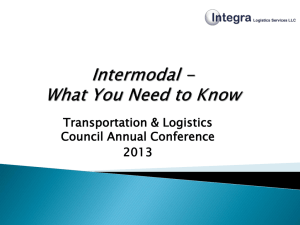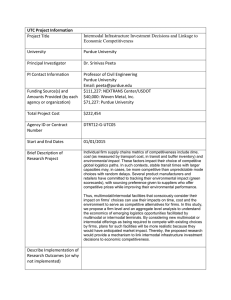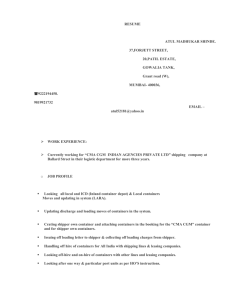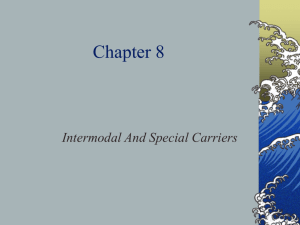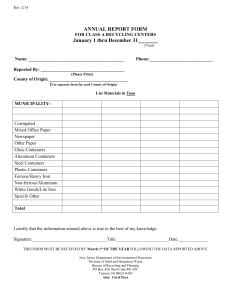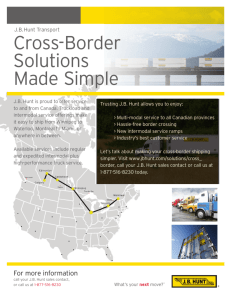-
advertisement
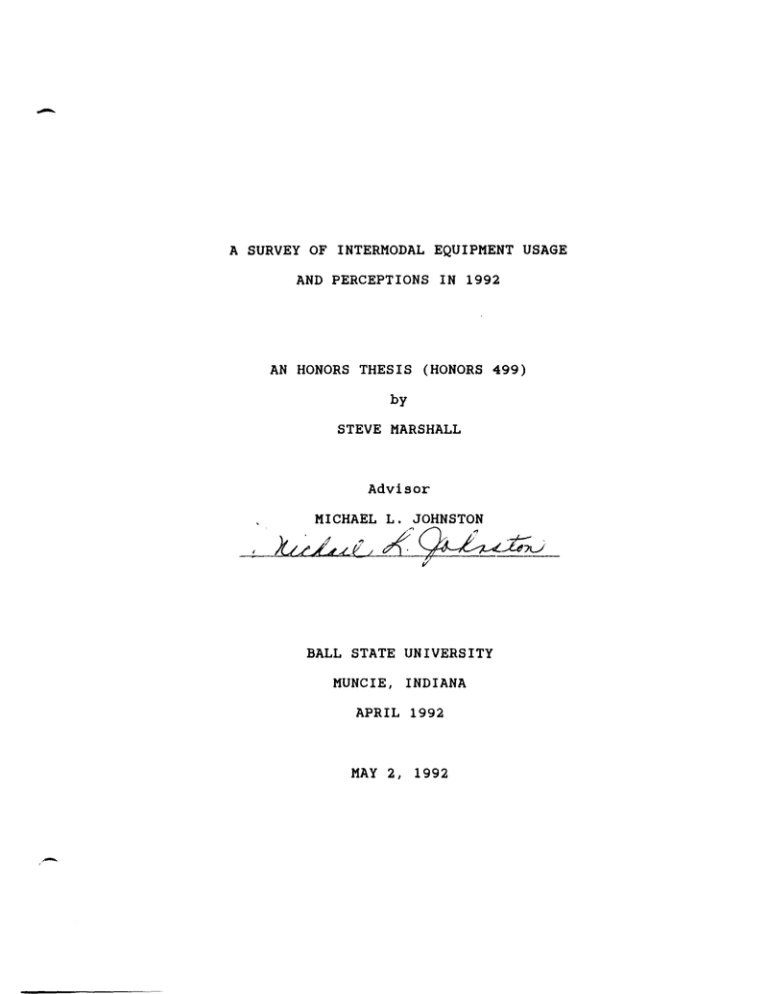
A SURVEY OF INTERMODAL EQUIPMENT USAGE
AND PERCEPTIONS IN 1992
AN HONORS THESIS (HONORS 499)
by
STEVE MARSHALL
Advisor
MICHAEL L. JOHNSTON
. 1
"
,
~"~
LilLa
/~
XJ'
BALL STATE UNIVERSITY
MUNCIE, INDIANA
APRIL 1992
MAY 2, 1992
-
c:.pC, :1
in 8::7 iD
~D
J'. Q
~J,':-' '
f
I
;:~
QiloL
• fv'3'7~
Table of contents
Thes i s Abstract . . . . . . . . . . . . . . . . . . . . . . . . . . . . . . . . . . . 1
Introduction . . . . . . . . . . . . . . . . . . . . . . . . . . . . . . . . . . . . . . 1
Types of Intermodal Equipment . . . . . . . . . . . . . . . . . . . . . 4
Container Equipment . . . . . . . . . . . . . . . . . . . . . . . . . . 4
Piggyback Equipment . . . . . . . . . . . . . . . . . . . . . . . . . . 5
RoadRailer Equipment . . . . . . . . . . . . . . . . . . . . . . . . . 6
Survey Methodo logy . . . . . . . . . . . . . . . . . . . . . . . . . . . . . . . . 8
Survey Responses . . . . . . . . . . . . . . . . . . . . . . . . . . . . . . . . . 10
Survey Interpretation . . . . . . . . . . . . . . . . . . . . . . . . . . . . 12
Perceptions
Capacity . . . . . . . . . . . . . . . . . . . . . . . . . . . . . . . 13
Flexibility . . . . . . . . . . . . . . . . . . . . . . . . . . . . 13
Ease of Loading/Unloading . . . . . . . . . . . . . . 14
Protection of Merchandise . . . . . . . . . . . . . . 15
Cleanliness of Equipment . . . . . . . . . . . . . . . 17
Recommendations . . . . . . . . . . . . . . . . . . . . . . . . . . . . . . . . . . 18
Appendix 1A
Survey cover letter . . . . . . . . . . . . . . . . . . . . 22
Survey . . . . . . . . . . . . . . . . . . . . . . . . . . . . . . . . . 23
Appendix 1B
Explanation of survey intent ........... 26
Appendix 2A
Tabulation of responses . . . . . . . . . . . . . . . . 28
Appendix 2B
Extra written responses to survey ...... 32
Appendix 2C
Unusual responses or problems .......... 34
with the survey
-
Appendix 3
List of states survey was
returned from . . . . . . . . . . . . . . . . . . . . . 35
Works Cited . . . . . . . . . . . . . . . . . . . . . . . . . . . . . . . . . . . . . . 36
-
Thesis Abstract
This thesis presents the results of a survey that was
mailed to 200 companies who purchase transportation in one
form or another.
The purpose of the survey is to present an
accurate
representation
equipment
users
and
of
states
united
what
their
perceptions
last
part
of
intermodal
are
of
the
thesis
is
an
equipment.
The
and
next
the
interpretation of the survey results.
used
to
recommendations
make
regarding what
addition.
if
type
the
of
to
transportation
equipment
shippers
are
The results will be
should be
saying
companies
offered.
things
about
In
the
equipment based on a lack of knowledge, some recommendations
will be made to help the sellers of transportation improve
the shipper understanding of available equipment.
Introduction
The field of transportation has undergone many changes
in
the
last
ten
considering the
,-
years.
This
should
tremendous technological
not
be
surprising
advancements that
have been made from the very early days of transportation to
the present time.
However, the last ten years in particular
have seen transportation rise to new heights in the areas of
.-.
technology, pricing, efficiency, and effectiveness in moving
the nation's freight.
Prior to 1980, all modes (air,
and
truck)
of
government.
transport
Carriers,
were
the
wat.er, rail,
regulated
companies.
by
pipeline,
the
who
federal
provide
the
transportation, were told the rates they could charge their
shippers.
the
As a result, there was little or no incentive for
carriers to provide
they
still
charge
could
if
poor
only
exemplary service.
charge
service
was
the
same
provided.
If they did,
rates
The
they
would
railroads
in
particular found it very difficul t
to compete under these
regulations.
business
They
steadily
lost
to
the
other
modes.
At the end of the Carter adminisb:-ation in 1979,
framework was set in place for deregulation.
the
The year 1980
is generally acknowledged as the year that transportation
was
set
free
from
the
bonds
of
regulation.
The
rate
regulation that remains to this day is mainly intended to
determine
if
a
transportation
company
is
taking
unfair
advantage of a shipper based on the fact that the company
has a monopoly advantage.
In addition, the area of safety
is still heavily regulated with respect to all the modes.
The 1980's saw competition between carriers of the same
mode
-
and
heights.
among
carriers
of
different
modes
to
new
The latitude in pricing that was allowed caused
many carriers to search for new ways to compete.
compete
rise
is
intermodal
transportation.
2
One way to
Intermodal
means
equipment that can be loaded with cargo and then transported
across
more
than
one
cargo being unloaded.
example,
can
only
be
mode
of
transportation
A conventional
used
on
a
without
the
railroad boxcar,
for
railroad.
To
move
its
contents via another mode all
the crates or boxes must be
unloaded
then
from
the
boxcar and
re loaded
onto
a
ship,
truck, airplane, etc.
The uniqueness of intermodal equipment is that the only
time the
loading/unloading process need take place
origin and final destination of the cargo.
is the
The advantages
are many including time savings, labor savings, and loss and
damage savings, among others.
The
writers
idea
of
Johnson
LogistiCS,
the
household goods
(123).
But,
intermodal
and
U.S.
is
Wood
in
Army
used
of military
prior to
the
not
new.
their
book,
containers
personnel
1980's
the
As
quoted
by
contemporary
to
transport
after World War
concept
II
never
came
close to reaching the widespread use it enjoys today.
The
carriers have come to see intermodal transportation as a way
to serve shippers better.
shippers
have
embraced
By the same token thousands of
intermodal
transportation
as
integral part of their daily transportation operations.
3
an
-
Types of Intermodal Equipment
There are
three
They
today.
available
of
intermodal
containers,
are
trailers and RoadRailers.
its own physical
types
bas i c
equipment
piggyback
truck
Each of these equipment types has
characteristics and each has a different
Each equipment type
group of present and potential users.
will be explained in detail.
Container Equipment
A container can best be thought of as a box.
can be set on a railroad flatcar,
hold of a cargo plane,
or a
This box
the deck of a ship,
flatbed truck trailer.
the
This
versatility between four of the five available modes makes
it very attractive.
According to Dan Croes of the Association of American
Railroads, the length of containers can. be 20,
45,
48,
or 53 feet.
foot
containers,
35, 40,
They can be a maximum of 102 inches
wide and are a minimum of 8 feet high.
53-
28,
when
10,965 pounds respectively.
empty,
The 45-,
weigh
9000,
48-, and
9800,
and
These three sizes are the most
popular today for intermodal transportation.
Shippers that ship and/or receive goods from and/or to
foreign points prefer containers for the transportation of
-
these goods.
necessary
countries,
This is because the air and water modes are
to
transport
particularly
freight
on
4
the
to
and
Asian
from
and
foreign
European
More
continents.
and
more
shippers
are
switching
to
containers for their international moves.
Piggyback Equipment
The piggyback trailer is a highway truck trailer that
can be loaded onto a railroad flatcar.
This provides for
f I exibi 1 i ty between the rai I and truck modes.
The trai I er
must be reinforced to withstand the rigors of rai I travel
and must be within any clearance restrictions the railroad
may have.
There
available.
are
several
dimensions
piggyback
trailers
Croes of the AAR cites trailers of 40, 45, and
48 feet as being the most popular.
trailers
of
are
restricted
to
Like the containers, the
inches
102
in
width
and,
in
general, can not stand more than 13 feet, 6 inches above the
ground.
are,
The empty weights for the above mentioned lengths
respectively,
14500,
15,000,
and 15,400 pounds.
can see by comparing trai lers and
containers
One
of the
same
length how much weight is added by the highway running gear.
Piggyback
transportation.
a
shipment
is
trailers
are
used
for
domestic
Often, either the origin or destination of
not served by
rai I .
To avoid
the
costly
transloading process, the trailer can be sent to a ramp and
loaded onto a rai lroad flatcar or vice-versa.
The use of
piggyback is very widespread in the United states.
the
large
piggyback
railroads
trailers
on
operate
trains
flatcars.
5
As
with
many
Most of
nothing
but
unprofitable
-
branchl ines
continue to
subsequently cut off,
this
equipment.
be
abandoned and rail
many shippers may be
The
al ternati ve
is
service
is
forced to use
to
use
trucks
exclusively from origin to destination, which some shippers
have done.
RoadRailer Equipment
The
third
RoadRailer
Division
is
of
type
equipment
a
registered
the
trademark
Chamberlain
Equipment
is
patented,
Equipment
Company
of
is
the
of
the
Group,
Inc.
and
marketed
bui I t
Duchossois
RoadRailer.
RoadRailer
RoadRailer
by
Inliustries,
Thrall
Chicago.
Conventional highway trailer manufacturers build the bodies
and
apply
hardware.
the
RoadRailer
under frame ,
running
trailer,
a
single-axle
On the Mark IV-
railroad "rheelset
is mounted
between the two highway axle wheelsets of the trailer.
on
the
and
The equipment looks like a conventional highway
truck trailer except for the running gear.
type
gear
highway,
the
railroad
wheelsets
lift
up
When
by
air
suspension between the highway axles and the trailer rides
like an ordinary truck trailer.
But, when on the railroad,
the railroad wheels are lowered by air suspension onto the
rails to
-
such a degree
that the
highwa.y axles are
lifted
clear.
The Mark V trailer is designed differently.
Because a
disadvantage of the Mark IV trailer is the extra weight the
6
-
railroad wheelset adds at the highway weighing stations, the
Mark V trai 1 er rai 1road running gear is detachab1 e.
the
trailer
lowered
goes
onto
a
from
the
highway
free-standing,
to
air
rail
mode,
suspension,
When
it
is
two-axle
railroad whee1set that is waiting at the rail/truck transfer
site.
Only one company currently provides RoadRai1er service
in this country -- the Norfolk Southern Corporation, a large
eastern
railroad.
According
to
statistics
provided
by
Triple Crown, the Norfolk Southern subsidiary who operates
the RoadRai1er
Mark
service,
IV trailers
width.
are
two
48
trailer sizes
feet
long
are available.
and are 102
The empty weight of Mark IV 48-
inches
in
foot trai 1ers is
17,900 pounds.
Hark
lengths.
V trailers
are
available
in
Like the Hark IV equipment,
48-
and
53-
foot
they are 102 inches
wide, but the empty weights for 48- and 53- foot equipment
are, respectively, 16,400 and 17,800 pounds.
The difference
in weights between the same-length trai 1er that has fixed
versus detachable railroad wheels is sUbstantial.
Although
current
RoadRailer
use
is
limited
in
comparison to containers and piggyback equipment, the chief
advantage is obvious.
-
trailers
from
equipment
is
equipment.
Fort
Wayne,
mode
To transfer containers and piggyback
to
mode
necessary.
Until
recently,
Indiana,
is
Not
expensive,
so
with
Triple Crown,
simply
piled
7
and
the
slow
lift
RoadRailer
at their hub in
up gravel
between
the
-
rails and the truck drivers drove their tractors right up on
the rai lroad
trailers.
anywhere
tracks and
either
picked up or
A transfer site can be
there
is
adequate
land,
dropped off
estclblished practically
preferably
near
major
highways or interstates.
RoadRailer service has gained, and
is
many
continuing
to
gain,
followers
who
are
eager
to
harness this important advantage.
Survey Methodology
To
gain
an
understanding
of
current
Intermodal
equipment usage patterns and shipper perceptions regarding
the equipment, a survey form was used.
This survey, a copy
of which is included in Appendix lA, was mailed to 200 users
of transportation across the United states and Canada.
The list of company names was taken from a reference
book
called
Commercial
The
Traffic
"Bluebook."
The
Official
Directory
Executives,
Bluebook
lists
of
Industrial
popularly
companies
and
known
as
the
two
ways
alphabetically and by the kind of products they manufacture
or produce.
were
listed
consumer
-
This
under
products
categorization
was
survey focused
on those companies
headings
that
would
categorization.
The
used
because
them
consumer
consumer
intermodal or highway forms of shipping.
8
put
that
in
the
products
products
favor
-
The
would
Bluebook
fit
into
lists
the
a
total
of
12,033
consumer products
companies
that
categorization.
In
order to generate a large enough survey sample from which to
draw significant conclusions it was decided to mail
of
the
survey
determined
sent
a
that
to
200
companies.
every 60th
survey.
To
name
determine
As
a
result
(12,033/200=60)
a
a copy
starting
it
was
would be
point
for
the
process a random number of 41.7 (or 42) was generated on a
scientific
first
calculator.
category of
Therefore,
the
consumer products
42nd
was
name
chosen,
on
the
and then
every 60th name thereafter.
Each company in the product listing has a number to the
side of it.
This number corresponds to its location in the
alphabetical
section of
address
list
and
of
the Bluebook.
traffic
Since
managers
is
the
only
company
in
this
section, the reference number was written down as each 60th
name was found.
The reference number was used to find the
full company listing in the alphabetical section.
Four databases, each with 50 names and addresses, were
compiled.
address
Each of the company entries had the full company
and the
listed.
A
chief traffic
cover
letter
or transportation executive
explaining
the
nature
of
the
project, a copy of the survey, and a self-stamped addressed
envelope were mailed to each of the 200 companies surveyed.
-
The
shippers
categories.
were
asked
questions
of
three
major
The questions asked what type of transportation
equipment they use now; what they thought they would use in
9
-
the future;
and most importantly, their perceptions of the
three major
types
of
intermodal
equipment
--
piggyback trailers, and RoadRailer equipment.
to all
of these questions
containers,
The responses
have been tabulated and can be
found in Appendix lB.
A total of 68 surveys
rate.
However,
were returned for a 34% response
8 surveys were unusable
for a
variety of
factors, including incompleteness and companies going out of
Thus, the survey results were compiled from the
business.
60
complete
usuable
and
surveys
returned.
Of
the
43
companies that responded to question 6 concerning current
intermodal
usage,
containers were the
wi th almost 91% using them.
61%,
of
the
respondents,
equipment of choice
Piggyback was used by 26,
to
this
question.
or
RoadRailer
equipment lagged far behind with only 25.6% of respondents
reporting usage.
No doubt this can be explained by the fact
that RoadRailer service is only provided predominantly east
of the Mississippi
River and has
limited available routes
within that area.
Survey Responses
The
about
response to
anticipated
questions
equipment
8
through
changes
10
which
revealed
shipper who said he planned to change equipment.
only
asked
one
A shipper
of a company with sales greater than $100 million reported
receiving and/or shipping over 100 intermodal movements per
10
day.
They
equipment,
traffic.
currently
however,
use
it
all
three
only
types
accounts
of
for
intermodal
5%
of
total
They plan to divert much more of their traffic to
the three intermodal equipment types in the next six months.
The
respondent
anticipated
listed
cost
change.
as
being
Obviously
-the
they
reason
plan
for
some
the
major
equipment shifts.
Questions
11
through
13,
which dt!alt
with equipment
perception, generated a wide range of responses.
59
respondents
containers.
was
answered
the
question
A total of
dealing
with
One area in which containers seemed to exce I
protection
of
merchandise
with
38,
or
64.4%,
of
respondents ranking this aspect as excellent or very good.
Containers did especially well in this area as compared to
piggyback.
This may reflect the fact that containers are
locked into place better on railcars than trailers are.
The
containers also have a lower center of gravity which tends
to prevent swaying and rocking.
to
examine
the
railcar
type
The survey did not attempt
(i.e.
conventional
flatcar
articulated spinecar, etc.) since shippers, generally,
no
control
over the
loading
of the
vehic I e
have
onto rai I car
types.
Piggyback
equipment
did
poorly
in
the
merchandise protection and equipment cleanliness.
these categories were rated excellent by only 1,
respondents, out of a total of 51.
11
areas
of
Each of
or 2%,
of
This was substantially
Piggyback did the
less than the other two equipment types.
poorest in these two areas of all the equipment types.
The
RoadRailer
overall.
more
equipment
enjoys
a
good
reputation
Of the 41 respondents to this question, there were
excellent
ratings
equipment types.
than
either
of
the
other
two
The RoadRailer equipment did particularly
well in the area of flexibility from road to rail and viceversa.
Five respondents, or slightly over 12%, gave it the
excel I ent rating.
The possibi I i ty exists that because of
its limited use and geographical area shippers gave it the
benefit of the doubt on the survey.
Survey Interpretation
A conversation recently reported in "Intermodal Service
As Some Tough Customers See It," at the 1991 meeting of the
National
Industrial
Transportation
League
made
the
point
"that there can be differences between what's perceived and
what is."
One major shipper noted that,
intermodal
performance
performance."
However,
"is
very
in his experience,
comparabl e
-
"People
truck
it was brought up that surveys show
"most shippers don't have that perception."
responded:
to
tend
to
measure
the
Yet the shipper
hell
out
of
intermodal, and just assume things about truck service.
It
is not as we 11 measured" (Rai 1 way Age 12).
This
exchange
demonstrates
an
between
important
a
consultant
point.
12
Despi te
and
the
a
shipper
fact
that
-
intermodal performance is comparable to truck performance.
shippers have the perception that truck service is superior.
Why the difference between reality and perception?
Most of
the difference is accounted for by communication gaps and,
in
some
miscommunication
cases,
shippers.
The
between
carriers can make definj.te
communication,
but also
carriers
and
improvements in
need to make. physical
changes
in
equipment offerings.
Perceptions: Capacity
On both aspects of capacity, cubic capacity and gross
weight,
there were
no surprises.
As
expected,
containers
did slightly better than the other two types of equipment in
the
area of
capac i ty.
Because piggyback
and
RoadRai I er
equipment is restricted by dimension and gross weight on the
highway
to
such
a
degree,
the only
wcly
to
improve
this
situation is to continue lobbying the Federal Government for
relaxed restrictions.
The carriers are very limited in the
equipment improvements that they can make here.
Perceptions: Flexibility
Shipper perceptions
surprising.
Containers
flexibility despite the
-
in the
did
fact
air, rail, sea, and highway.
the other hand,
highway.
no
area of
better
that they
flexibility
in
the
area
use
Piggyback and RoadRailers,
of
13
of
can be shipped by
are onl y interchangeabl ,8 between rai I
International
were
piggyback
and
on
and
RoadRai I er
-
equipment is not practical, but it can be used on roll onro 11
off ocean vesse 1 s
or barges.
One recommendation to
carriers who are marketing container service is to stress to
shippers
not
the tremendous
just
for
flexibility that
international
domestic transportation.
to
domestic
shippers
ship
and/or
transportation,
but
have,
also
for
This flexibility is advantageous
because
boundaries continue to
to
containers
as
international
business
disappear, a need may arise quickly
receive
from
an
international
point.
Containers will allow for this quick change.
Perceptions: Ease of Loading/Unloading
Containers
did
loading/unloading.
reasons.
the
This
best
is
in
the
understandable
area
for
of
several
One reason may be that piggyback and RoadRai I er
equipment is tied up while the loading/unloading process is
taking
place.
trailers
and
Containers
treated
as
loading/unloading process.
are
placed
highway
on
chassis
trailers
during
They are not removed
frame
the
from the
chassis trailers until they arrive back at the rail yard,
airport or pier.
needed
and
the
With containers, only the container box is
flatbed
truck
trailer,
railroad
flatcar,
ship, or airplane can be hauling other loads while that box
is
being
loaded/unloaded.
Since
container
and
chassis
trailers generally are accompanied by tractors and drivers
for
loading or unloading,
detention accrues
truck tractor and the shipping container.
14
for
both the
Since there is
quicker turnaround of the container equipment, there often
is no demurrage charged by the rai lroad or ocean carrier.
Demurrage
payments
and
that
detention
shippers
charges
must
refer
to
the
pay when they hold
penalty
equipment
In this
beyond a certain length of time, usually 48 hours.
way, the increased ease of loading and unloading containers
allows
for
better
equipment
utilization.
The
carriers
should reinforce this strong point of containers but should
also make an effort to alleviate some of the demurrage and
detention charges on the piggyback and RoadRailer equipment.
Perceptions: Protection of Merchandise
Containers and RoadRailer equipment did the best in the
area
of
merchandise
protection.
This
is
predictable
considering the swaying and rocking that often occurs when
the trailers sit on conventional railroad flatcars.
One shipper, a manufacturer of electronics,
merchandise
protection
equipment types.
was
a
problem
with
To quote the responde!nt,
felt that
all
three
"the nature of
our product and our customer base dictate that the majority
of our shipments move via padded, air ride [highway] service
and largely within North America.
rai I
as
a
common mode due
to
We have never considered
added expense
(crating and
loading) and added exposure (rougher handling) compared with
-
padded/air ride."
all
three modes
To improve the merchandise protection of
the
carriers need to
continue to
provide
incenti ves to their own employees to protect the shipper IS
15
-,
freight.
To prevent damage from occurring in the mode-to-
mode transition time the lift operators need to be carefully
instructed on how to minimize damage.
While in transit, for
example on a railroad, the train crews need to be instructed
on how to most gently stop and
start their trains.
The
maximum speeds for coupling cars that have been established
must be enforced.
Because
piggyback
recommendation
is for
inherently
the carriers
causes
more
damage,
to encourage
my
shippers,
where possible, to change from piggyback to either container
and/or
that,
RoadRai ler.
"containers
One
seem
shipper
to
be
surveyed
so
agreed
advantageous
stating
over
TOFC
[trailer-on-flatcar or piggyback] both for shippers and the
RR I S
[rai lroads] ,
I I d 1 ike to someday see a system set up
for domestic containers to be routinely shipped within all
points of the U.S., not intended for ocean use but intended
as replacements for piggyback trailers."
However, with the newer articulated, spine flatcar that
is
in common use today,
the
argument put
becoming increasingly invalid.
the
swaying
Trailers
ride
and
slack
center of gravity.
above
is
This new flatcar eliminates
action
lower on the
forth
of
cars,
conventional
which allows
flatcars.
for
a
low
The ride is identical to doubl e-stack
train equipment which refers
to the
containers two high on five-car sets.
buying the spine flatcars now.
soon be obsolete.
16
practice
of
stacking
Rat lroads are only
The conventional
car wi 11
.-.
Perceptions: Cleanliness of Equipment
The area of cleanliness revealed some serious problems
with
piggyback
answered.
the
equipment.
piggyback
Of
the
51
perception
respondents
question,
who
only
22
respondents, or 43%, ranked the cleanliness as excellent or
very
good.
Only
excellent.
one
respondent
ranked
cleanliness
as
The perception may have something to do with the
fact that refrigerated piggyback trailers are used for food
transportation.
small
Although refrigerated trailers are a very
percentage
of
the
total
piggyback
equipment could affect shipper perception.
fleet,
this
The movement of
the trailers is such that the trailer needs to be washed on
the interior after one use.
for
a
period
trailer
leave
important to
materials
of time,
the
much
be
to
If this washing doesn't occur
smell
and
desired.
Cleanliness
shippers and receivers
are
either
going
cleanliness
of goods
directly
into
production process or to retail outlets.
of
is
the
very
because the
a
sensitive
If the merchandise
shipped is visibly unclean or smells badly it could effect
the receiver's perceptions of the company that sold them the
goods.
One way to solve this problem is for the carriers to
concentrate on quality control at the transfer site (ramp,
pier,
etc.).
unloading
interior
of
of
The
the
the
person
car
in
should
piggyback
charge
be
of
the
required
trailers
to
to
ensure
cleaniliness before sending the trailer on for
17
transfer
check
its
or
the
basic
loading at
-.
The idea is to never allow an unclean
the nex1: shipper.
trailer to reach a shipper's facility.
Based on the results
of the survey, the carriers particularly need to stress this
with the piggyback equipment.
The
overall perceptions
of the
three equipment
types
indicated that shippers thought the RoadRailer equipment was
the
best based on the eva I uated
criteria.
The
container
eqUipment ranked a close second and the piggyback equipment
was
a
distant
garnered
third.
very
categories.
few
Of
51
Overall,
excellent
shippers
the
piggyback
rankings
who
on
answered
equipment
any
the
of
the
piggyback
perception question, no more than two an3wered excellent in
anyone category.
Recommendations
As mentioned previously,
TripI e
three
Crown RoadRai I er
equipment
the overall
servi ce
types.
were
Despite
ratings for
·the highest
the
fact
that
the
of
the
only
11
respondents, or 25.6%, of a total 43 who answered question 6
currently
use
RoadRailer
equipment,
it
was,
overall,
perceived as better than container or piggyback equipment.
-
Triple Crown has
done an excellent
positive
of RoadRai 1 er equipment
aspects
shippers.
Northwest
One
with
RoadRailers
exception
a
are,
plant
in
despite
was
a
Chicago
the
18
job of instilling the
in the
shipper
whet
presence
minds
based
in
of
the
didn't
know
of
RoadRailer
a
what
facility
in
the
Chicago
However,
area.
familiarity was the exception,
this
not the rule,
lack
of
since he had
never had sales contact by a Triple Crown representative.
In
addition
RoadRailer
to
equipment
stressing
has
over
the
physical
containers
advantages
and
piggyback,
Triple Crown should make the point in their brochures and
sales contacts that they are the only service of their kind
in
North
America.
experimented with,
Al though
several
rai lroads
have
and are planning to use, the equipment,
Triple Crown is currently the sole user.
Despite the fact
that
this
uniqueness
help
demonstrate
uniqueness
to
is
temporary,
their
customers
this
'their
would
commitment
to
innovation and their desire to develop better transportation
equipment.
Some shippers indicated in the survey that they
were unsure of whether or not Norfolk Southern operated the
only RoadRailer service.
RoadRailer
equipment
other RR' s
[rai lroads]
One shipper, who currently uses
stated,
"As
a
shipper,
I
hope
that
initiate the road-rai ler system,
or
if they have they should market it better so lid be aware of
its availability.
the
The only one I'm using or am aware is in
operation
is
NS
(Norfolk
Southern]
Triple
Crown
Service . "
Triple Crown needs to make sure everyone knows
that they are the only service of this type in operation.
They have the opportunity to turn this exclusiveness into an
-
important competitive advantage against other carriers.
There seems to be some serious misconceptions about the
service that intermodal-using carriers provide.
19
Service has
become
more
important
inventory systems.
in
the
with
the
advent
of
"Just-in-Time"
A case in point is a discussion reported
intermodal
article
domestic/international
mentioned
shipper
above.
said
that
One
large
transportation
companies, especially those future multimodal ones, "will be
judged on
said,
performance
and
then on economics."
"We know that inherently intermodal
than truck.
Another
should cost less
But you have to sell the user on performance
before you talk price" (Railway Age 12).
At least two shippers surveyed expressed complaints and
concerns in the area of service.
steel,
receives
plastics,
and
One company who ships and
chemicals
"Inter-modal moves are more di fficul t
to trace,
obtain promised delivery dates/times."
products and seasonal gifts remarked,
product
perishability
reduces
carriers
have
either
not
that,
expedite or
A shipper of food
"Time sensitivity and
the
intermodal delivery for our business."
the
stated
effectiveness
of
The problem is that
communicated
with
these
shippers regarding intermodal or the communication that did
take place was not accurate or clear.
is
that
a
certain
level
of
Another possibility
service was
promised and not
delivered.
It is possible, and if the shipment volumes are large,
it is likely that at one time or another a carrier will not
be able to keep their side of the transportation agreement.
What is needed is more than a
carrier
to
the
shipper.
flow of information from the
Information,
20
in
the
form
of
performance evaluations,
the carrier.
needs to flow from the shipper to
This way the carrier will know two things:
what the performance criteria are and how the carrier ranks
on each of the evaluated criteria.
The need for two-way communication applies to all three
equipment types.
Based on the
answers
to the
perception
questions in the survey, there is room for vast improvement
in every criteria of every
equipment type.
Yes,
many of
these answers were based on perception and not actual usage,
but if a shipper has a poor perception of an equipment type,
they will not use it.
Further equipment improvement will be
hard to come by if shippers do not begin to consistently and
regularly
Only
by
carriers
evaluate
receiving
carriers
and
give shippers
on
their
evaluating
current
shipper
the intermodal
feedback
equipment that
must have to satisfy their transportation needs.
21
equipment.
can
they
,February 29, 1992
Dear :
My name is steve Marshall and I am a senior at Ball state
University in Muncie, Indiana.
As an honors student
enrolled in Ball state's Honors College, I am required to
complete a senior thesis project. The subject of my senior
thesis will be a look at shipper's perceptions of different
types of intermodal equipment.
Intermodal equipment
includes containers, piggyback truck trailers and Road
Railer equipment (ie. highway to rail).
Questionnaire recipients were chosen entirely at random from
The Official Directory of Industrial and Commercial Traffic
Executives. All :lndividual questionnaires returned will
remain confidenti.!l. Results will be tabulated based upon
total returns only. No further attempt will be made to
contact you. Please feel free to verify the nature of this
research by contacting myself at 317-288-5046 or my advisor,
Michael Johnston, Division Transportation Manager, Delco
Remy, at 317-646-3488.
The questionnaire consists of 13 questions.
your questionnaire to me by March 20, 1992.
Please return
Thank you for taklng the time to assist me in my research.
Sincerely,
steve Marshall
22
1.
What type of raw materials and finished products do you
receive or ship?
2.
Please check the approximate sales level of your
company (optional).
$5M - $20M
$20M-$100M
above $100M
$200,000 or less
$200,000 - $1M
$1M-$5M
3.
How many plants or locations does your company ship or
receive from?
4.
Does any of your traffic (inbound and/or outbound)
move in intermodal equipment?
Yes
No
If not, please skip to question 11.
5.
How often do you receive or ship materials or products
using intermodal? (Check applicable level)
4 or fewer times per year
12 or fewer times per year
4-8 times per month
6.
What type of intermodal equipment do you use?
all that apply)
Containers
Piggyback
7.
-
3-5 times/week
Average daily
(check
Road-Railers
What percentage of your total traffic moves in each of
these equipment types?
Con-tainer:
0-25%
25-50%
50-75%
75-100%
Piggyback:
0-25%
25-50%
50-75%
75-100%
Road-Railer:
0-25%
25-50%
50-75%
75-100%
-
8.
Do you plan to change to another type of shipping
equipment within the next 6 months?
No
Yes
If not, please skip to question 11.
9.
Why do you plan to change equipment?
apply)
(Check all that
More effective for product
New equipment perceived as being better
Change in good being produced
Cost
10.
What type of shipping equipment do you expect to use
in the future? (check all that apply)
Containers
Piggyback
Road-Railers
Boxcars
___ Airplane
Covered hopper
Water vessal
Conventional truck trailer
Please answer the following three qUElstions regardless
of whether you use these types of equipment.
11.
Please indicate your perception of container shipping
by marking the space that best represents your current
appraisal of the equipment.
Excellent
Capacity
Cubic Capacity
Gross Weight
Flexibility from
mode to mode
Ease of loading/
unloading
Protection of
merchandise
Cleanliness of
equipment
Very Good
Fair
Poor
12.
Please indicate your perception of piggyback shipping
by marking the space that best represents your current
appraisal of the equipment.
Excellent
Very Good
Fair
Poor
Capacity
Cubic Capacity
Gross Weight
Flexibility from
mode to mode
Ease of loading/
unloading
Protection of
merchandise
Cleanliness of
equipment
13.
Please indicate your perception of Road-Railer shipping
by marking the space that best represents your current
appraisal of the equipment.
Excellent
Very Good
Fair
Poor
Capacity
Cubic Capacity
Gross Weight
Flexibility from
mode to mode
Ease of loading/
unloading
Protection of
merchandise
Cleanliness of
equipment
Please note any other perceptions or comments you may have
regarding intermodal equipment or shipping on the back of
this page.
Thank you for your time and cooperation!
APPENDIX IB
The following is an explanation of the intended meaning
of
the
survey
questions.
A copy
of
the
survey
is
in
Appendix 1A.
Questions 1-3
The first three questions were intended
to be general
information questions for
the purpose of categorization only.
For
example, if a company had no knowledge
of Road-Railer equipment, answers
$200,000 or less and 2 locations on
question 2 and 3, this would help
explain the lack of knowledge.
Question 4
This question was intended to determine
the rate of present intermodal equipment
usage.
It also steered the respondent
to questions 11-13.
Question 5
Attempted to determine usage rates for
intermodal equipment.
Questions 6-7
These questions were intended to
determine the type of intermodal
equipment used and the
26
amount of
current usage of each of the three types
of equipment.
Questions 8-10
These three questions were intended to
determine the intention to change
equipment.
The questions also tried to
determine the reason for the planned
change and to what type of equipment the
change would be.
Question S, if
answered in the negative, also served as
a transition to Question 11.
Questions 11-13
These questions were intended to provide
a measure of shipper perceptions of the
three major intermodal equipment types.
Perceptions of the physical aspects of
the equipment, not cost or service
characteristics, were the only factors
measured. Respondents were instructed to
answer these questions regardless of
usage or first-hand experience.
The
questions were intended to measure
perceptions.
27
APPENDIX 2A
Following
is
completed surveys.
the
tabulated
responses
of
the
60
The percentages have been computed by
dividing the number of respondents per answer by the number
of total respondents (n number) to the question.
28
incomplete surveys n=8
completed surveys n=60
-~ :51
1.
What type of raw materials and finished products do you
receive or ship?
85% of completE!d surveys answered this question
n=53
(88.3%)
2.
Please check the approximate sales level of your
company (optional).
written responses
(9.4%L.L~
n=60
(11.3%) -.6... $5M (20.7'10) ~L
(52.8%)
~
$20M
$20M-$100M
above $100M
$85 M
(1. 9"/0)
over $1 billion (1.9
$3 billion (1.9"/0)
3.
How many plants or locations does your company ship or
receive from?
4.
Does any of your traffic (inbound and/or outbound)
move in intermodal equipment?
( 100%)
n=60
$200,000 or less
$200,000 - $lM
$1M-$5M
( 100'10)
(68.3%) 41
Yes
(31.6%) -.UL No
If not, please skip to question 11.
n=42
5.
(70%)
(7.1%)
(23.8%)
(16.7%)
How often do you receive or ship materials or products
using intermodal? (Check applicable level)
3 4 or fewer times per year
10
7
wrl1~ten responses:
n=43
(71. 7%)
6.
~
12 or fewer times per year
4-8 times per month
3-5 times/week (28.6%)
-L Average daily (9.5%)
10/day, l~/day, 20/day, 30/day, 100+/day, and
25-30 times per year
What type of intermodal equipment do you use?
all that apply)
(90. 7'10) ~2_
Containers
(25.6%)
~
(check
Road-Rai lers
(60.5%) _2.Q Piggyback
n=43
(71. 7%)
-
7.
What percentage of your total traffic moves in each of
these equipment types?
n=39 Container \ 84 .6%)~ 0-25%
(5.1%)-2 25-50%
_1_ 50-75% (2.6%)
_3_ 75-100% (7.7%)
n=26 Piggyback~80.8%)~ 0-25%
(11.5%) 3 25-50%
_2__
--
n=l1 Road-Rai ler :82% ~ 0-25%
18 . 2"10--.2_ 25-50%
50-75%
75-100% (7.7%)
50-75%
75-100%
-
n=- .
B.
Do you plan to change to another type of shipping
equipment within the next 6 months?
(2.3%) ~ Yes
(97 .3%)~ No
If not, please skip to question 11.
n=l
9.
Why do you plan to change equipment?
apply)
(Check all that
More effective for product
New equipment perceived as being better
Change in good being produced
X Cost
n=l
10.
What type of shipping equipment do you expect to use
in the future? (check all that apply)
x Containers
X Piggyback
X Road-Rai I ers
Boxcars
Airplane
Covered hopper
--- Water vessal
Conventional truck trailer
Please answer the following three questions regardless
of whether you use these types of equipment.
n=59
11.
Please indicate your perception of container shipping
by marking the space that best represents your current
appraisal of the equipment.
Excellent
Very Good
Fair
Poor
no answer
-
Capacity
Cubic Capacity
Gross Weight
_L(5.1%)
JL.. (62.7%)
_L( 6. SOlo)
35_(59.3%)
13 (22%)
__4__ (6.8%)
3 (5.1%)
1
4
Flexibility from
mode to mode
~(6.8%)
2fL{47.4%)
.2L( 39%)
_ 1 (1. 7"10)
3
Ease of loading!
unloading
_3_(5.1%)
1Lj71.2%)
~(20.3%)
__2_(3.4%)
Protection of
merchandise
_7_(11.9%)
lLj52.5%)
~(30.5%)_1 (1.7%)
2
Cleanliness of
equipment
_4_(6.8%)
&j50.1%)
~(33.9%) _ 3 (5.1%)
2
30
~(23.7%)
-
12.
Please indicate your perception of piggyback shipping
by marking the space that best represents your current
appraisal of the equipment.
Excellent
Very Good
Fair
Poor
no answer
Capacity
Cubic Capacity
Gross Weight
_L (3.<f'1o)
~ (69.2"10)
2 (3.9%)
FlexibilIty from
mode to mode
n=41
...:L{ 17 .6%) _2 (3.<f'1o)
~2 (63.5%)
1 ( 2"10)
1l.J 2 5. 5%) - -
2
2
_32 (61.5%)
~
1
(29.4%)_3 (5.9%)
Ease of loading/
unloadinq-
_2 (3.9%)
_ 34 (66.7%)
1 (2%)
-13- (25.5%) - -
1
Protection of
merchandise
_L (2%)
_24 (IJ 1. 1%)
~
1
Cleanliness of
equipment
_L
13.
21 ( 41. 2"10)
(2"10)
(39.2%)_5 (9.8%)
~(51%)
1 ( 2%)
2
Please indicate your perception of Road-Railer shipping
by marking the space that best represents your current
appraisal of the equipment.
Excellent
Very Good
Fair
Poor
no answer
Capacity
Cubic Capacity
Gross Weight
8 (19.5%)
(19.5%)
2 (4.9%)
5 (12.2%)
28 (68.3%)
15 (61%)
_~
~(48.8%)
~
4 (9.8%)
2L(56.1%)
--1l (13. 7%)_
Protection of
merchandlse
___i. (9.8%)
~(51.2%)
15 (36.6%) 1
Cleanliness of
equipment
_4 (9.8%)
~(46.3%)
Flexibility from
mode to mode
Ease of loading/
unloading
2 (4.9%)
1_(2.4%)
_2 (12. 2"10)
(31. 7%)_2_(4.<f'Io)
-.lQ. (3<f'1o)
1 (2.4%)
Please note any other perceptions or comments you may have
regarding intermodal equipment or shipping on the back of
this page.
Thank you for your time and cooperation!
al
1
2
1
1
1
APPENDIX 2B
Extra written responses to survey.
1.
As a shipper, I hope that other RR's initiate the Road-
Railer system, or if they have they should market it better
so I'd be aware of its availability.
The only one I'm using
or am aware is in operation is the NS Triple Crown Service.
Also,
containers seem to be so advantageous over TOFC
both for shippers and the RR' s,
system
set
up
shipped wi thin
ocean
use
but
for
all
domestic
points
of
intended
as
I'd I ike to someday see a
containers
the
U. S.,
to
be
not
intended
replacements
for
routinely
for
piggyback
trailers.
2.
The
use of
containers
in stack train service is
too
limited and needs to be greatly expanded to realize its full
potential.
3.
Time sensitivity and product perishability reduces the
effectivness of intermodal delivery for our business.
4.
Intermodal moves are more difficult to trace,
expedite
or obtain promised delivery dates\times.
5.
Due to the secure nature of the majority of our larger
shipments,
transit
times
and
traceabi I i ty of
our
product
require us to steer away from multi-modal freight services.
32
6.
Our
company
that
consider
uses
very
little
our
forwarders
intermodal
are
using
(unless
you
intermodal
consolidations on our behalf.)
I
am
fami I iar with
some
of
the
advancements
in
the
Road-Railer area, but not as a firsthand experience.
Majority of intermodal
has been sea containers moving
finished product in full containers from West Coast to Far
East, Australia and New Zealand, some to Latin America.
Perceptions of equipment availability:
Sea
Pig
RoadRailer
Hi Cube
few
some
many
Hi Gross
some
many
few
The nature of our product and our customer base dictate
that the majority of our products move by a padded, air ride
service
and large ly wi thin North America.
considered
rail
as
a
common
mode
due
to
We have
added
never
expense
(crating and loading) and added exposure (rougher handling)
compared with padded\air ride.
33
APPENDIX 2C
Unusual responses or problems with the survey
The
major
problem
was
that
many
respondents failed to follow directions.
of
the
survey
Many of them did
not skip questions when instructed and some did not answer
questions 11 through 13 despite being instructed to.
Since
the thesis focused on equipment perception, every survey on
which questions 11 through 13 were answered was considered
valid.
The fact that directions were or were not followed
prior to these questions was not felt to skew the results of
questions 11-13.
The
60
responded
percentage
about
the
surveys
or
were
valid
for
use
the
purpose
of
this
and
for
30%
of
the
whole population could
percentage.
34
total
was
a
thesis.
sample
large
that
enough
Conc I usions
be drawn based
on this
-
APPENDIX 3
List of states from which valid surveys were received
No. of responses
state
Arkansas
California
Connecticut
Florida
Georgia
Illinois
Indiana
Iowa
Kansas
Massachusettes
Michigan
Minnesota
Mississippi
Missouri
Nebrask.a
New Jersey
New York
North Carolina
Ohio
Oklahoma
Ontario, Canada
Oregon
Pennsylvania
Quebec, Canada
Rhode Island
Tennessee
Texas
Virginia
Washington
West Virginia
Wisconsin
No postmark
1
3
2
1
2
2
2
2
1
1
4
3
1
2
1
4
4
2
6
1
1
1
3
1
1
1
3
1
1
1
1
1
Total
60
35
Works Cited
Croes, Dan. Telephone interview. 20 Jan. 1992.
"Intermodal Service as Some Tough Customers See It." Railway
~~.
Jan. 1992: 12.
Johnson, James C., and Donald F. Wood. Contemporary
Logistics.
New York: MacMillan, 1990.
Koch, Teresa. Telephone interview.
20 Jan. 1992.
The Official DirE!ctory of Industrial and Commercial Traffic
Executives. New York: K-III Press, 1991.
--
